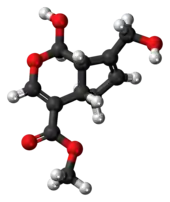 | |
 | |
| Names | |
|---|---|
| Preferred IUPAC name
Methyl (1R,4aS,7aS)-1-hydroxy-7-(hydroxymethyl)-1,4a,5,7a-tetrahydrocyclopenta[c]pyran-4-carboxylate | |
| Identifiers | |
3D model (JSmol) |
|
| ChEMBL | |
| ChemSpider | |
| ECHA InfoCard | 100.164.015 |
| KEGG | |
PubChem CID |
|
| UNII | |
CompTox Dashboard (EPA) |
|
| |
| |
| Properties | |
| C11H14O5 | |
| Molar mass | 226.226 g/mol |
Except where otherwise noted, data are given for materials in their standard state (at 25 °C [77 °F], 100 kPa).
Infobox references | |
Genipin is a chemical compound found in Genipa americana fruit extract. It is an aglycone derived from an iridoid glycoside called geniposide which is also present in fruit of Gardenia jasminoides.[1]
Genipin is an excellent natural cross-linker for proteins, collagen, gelatin, and chitosan cross-linking. It has a low acute toxicity, with LD50 i.v. 382 mg/kg in mice, therefore, much less toxic than glutaraldehyde and many other commonly used synthetic cross-linking reagents. Furthermore, genipin can be used as a regulating agent for drug delivery, as the raw material for gardenia blue pigment preparation, and as the intermediate for alkaloid syntheses.[2]
The blue color of genipin is stabilized in milk due to the natural pH of milk [3]
In vitro experiments have shown that genipin blocks the action of the transporter uncoupling protein 2.[4]
References
- ↑ Ramos-de-la-Peña, A.M.; Renard, C.M.G.C.; Montañez, J.; Reyes-Vega, M.L.; Contreras-Esquivel, J.C. (2014), "A review through recovery, purification and identification of genipin", Phytochemistry Reviews, 15: 37–49, doi:10.1007/s11101-014-9383-z, S2CID 16614004
- ↑ Brenda Vaandering, Genipin, retrieved 22 December 2019
- ↑ M.I.L. Neves, A. Valdés, E.K. Silva, M.A.A. Meireles, E. Ibáñez, A. Cifuentes (2022), "Study of the reaction between genipin and amino acids, dairy proteins, and milk to form a blue colorant ingredient", Food Research International, 157: 111240, doi:10.1016/j.foodres.2022.111240, hdl:10261/311292, PMID 35761551, S2CID 248205719, retrieved 9 December 2022
{{citation}}: CS1 maint: multiple names: authors list (link) - ↑ Zhang, CY; Parton, LE; Ye, CP; Krauss, S; Shen, R; Lin, CT; Porco Jr, JA; Lowell, BB (2006). "Genipin inhibits UCP2-mediated proton leak and acutely reverses obesity- and high glucose-induced beta cell dysfunction in isolated pancreatic islets". Cell Metabolism. 3 (6): 417–27. doi:10.1016/j.cmet.2006.04.010. PMID 16753577.